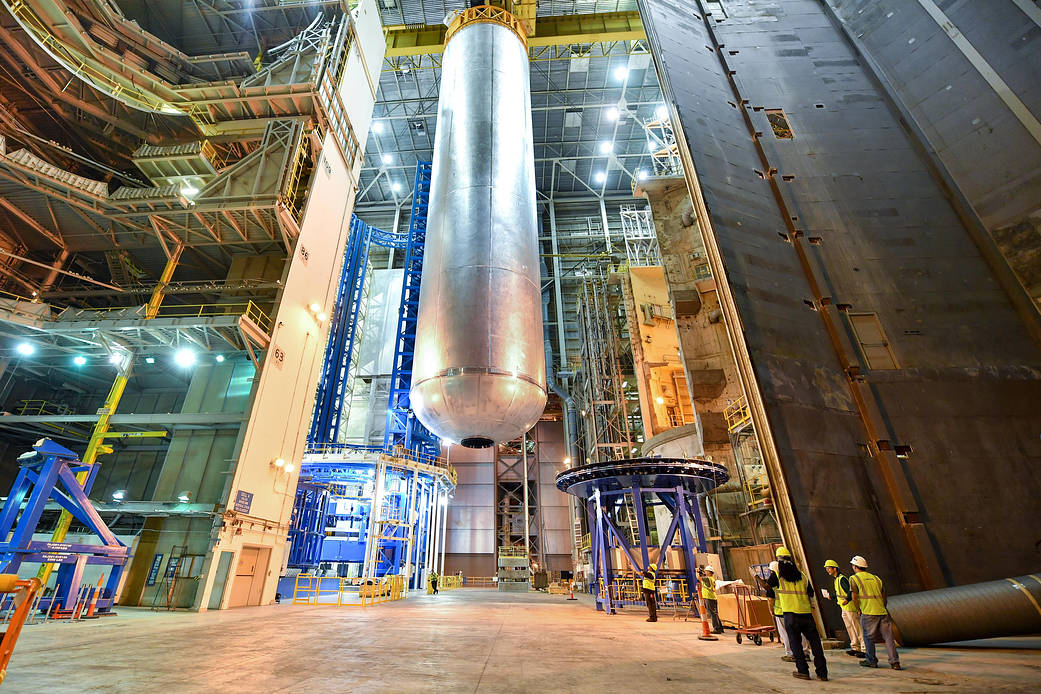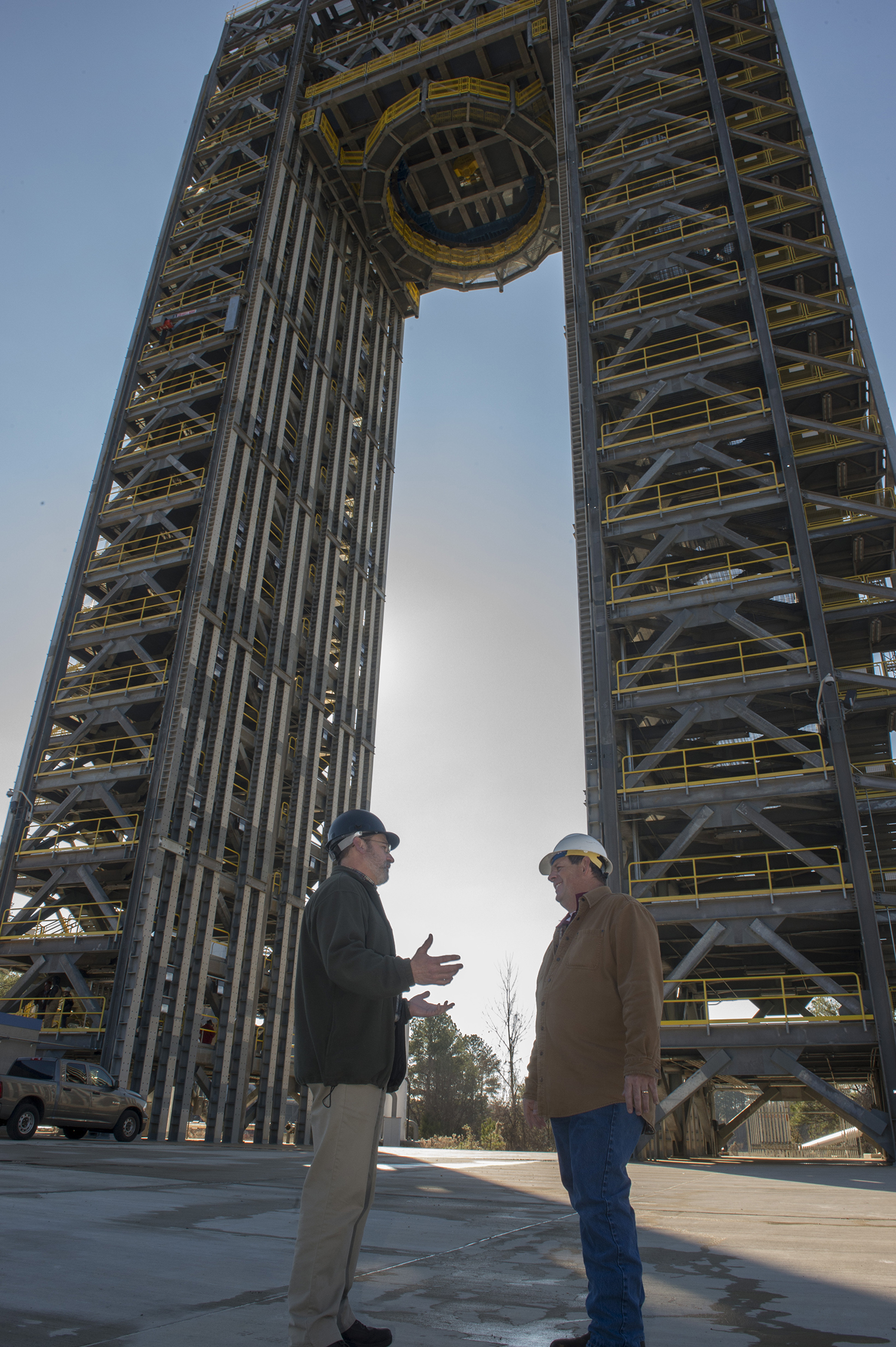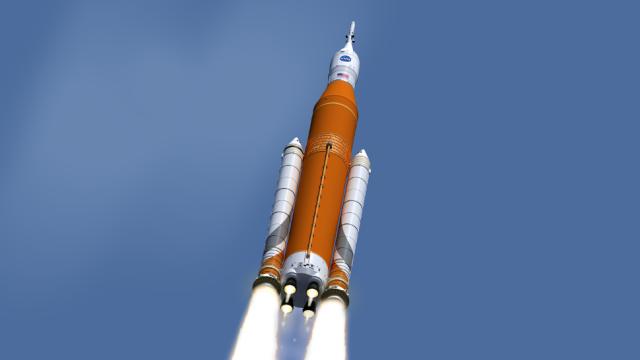Late next year, NASA is hoping to launch its Space Launch System — a powerful next generation rocket capable of exerting 900 tonnes of thrust. NASA engineers have now completed construction of a stand sturdy enough to test its enormous fuel tank. It’s an important milestone, and another step towards sending humans to Mars.
An artist’s rendition of NASA’s Space Launch System. If you think it looks a bit like the Space Shuttle, you’re not wrong. Technology from the now-retired Shuttle mission is being used for the SLS program. (Image: NASA)
Construction on test stand 4693 began in May 2014 and finished in December 2016. The structure stands 67m tall, and is located at NASA’s Marshall Space Flight Center in Huntsville, Alabama. To commemorate the end of the major construction phase, NASA released a 60-second timelapse showing the platform as it was being built.
Engineers are now installing the equipment needed to test the rocket’s biggest fuel tank, including cables, pipes, valves, control systems, cameras, lighting and specially-designed test equipment. This test site will be critical in ensuring that the SLS’s 2,032,765l liquid hydrogen tank can withstand the extreme forces it will have to endure during launch. This tank is part of the SLS’s massive four-engine core stage, which is slated to send the Orion spacecraft and its four occupants on a journey around the moon. Importantly, it’s the same technology needed for the journey to Mars.

The massive fuel tank that’s slated to be tested at the new Marshall platform. (Image: NASA/MAF/Steven Seipel)
“The scale and capability of this test stand are unique, and creating it has taken people from across the country, from all walks of life — concrete suppliers and finishers, steel fabricators and erectors, bolt manufacturers and more,” noted Robert Bobo, manager of the SLS structural strength testing at Marshall, in a statement. “Everyone who’s touching this is proud of the Space Launch System, an American rocket that will send astronauts farther in space than humans have ever travelled before.”

NASA engineers Robert Bobo (left) and Mike Nichols (right) talk beneath the 67.36m-tall Test Stand 4693. (Image: NASA/MSFC/Emmett Given)
The new stand is designed to simulate the powerful dynamics of launch and flight by pushing, pulling, and bending a prototype of the 45.42m-long liquid hydrogen tank, which was recently constructed by Boeing at NASA’s Michoud Assembly Facility in New Orleans. This tank is so big and heavy that it will have to be delivered to the test site on a barge. Once mounted on the stand, the liquid hydrogen tank, along with a liquid oxygen tank, will feed 2.7 million litres of super-cooled propellant to four RS-25 engines, producing 900 tonnes of thrust at the base of the core stage.

Behold Pegasus, the barge that will carry parts of the Space Launch System from NASA’s Michoud Assembly Facility in New Orleans to the Marshall Space Flight Center in Huntsville, Alabama, and later to the Kennedy Space Center. (Image: NASA/Michoud/Steven Seipel)
A total of 38 hydraulic cylinders, ranging in weight from approximately 230 to 1500kg, will be positioned at points along the tank to simulate the thrust produced by the RS-25 engines. During testing, these cylinders will extend and retract, pushing and pulling in different combinations to expose the hydrogen tank to the conditions expected at launch. These cylinders, or “loadlines”, are capable of applying thousands of tonnes of both pulling and crushing force, and up to approximately 1.5 million newtons of shearing (or sideways) force. As this is happening, more than 3500 individual measurements will be taken, including temperatures and pressures. Over 30 different tests are scheduled in a process that will take several months.
Lastly, the new stand will be equipped with high-definition cameras, so get ready from some really cool visuals once testing begins later this year!
[NASA]
